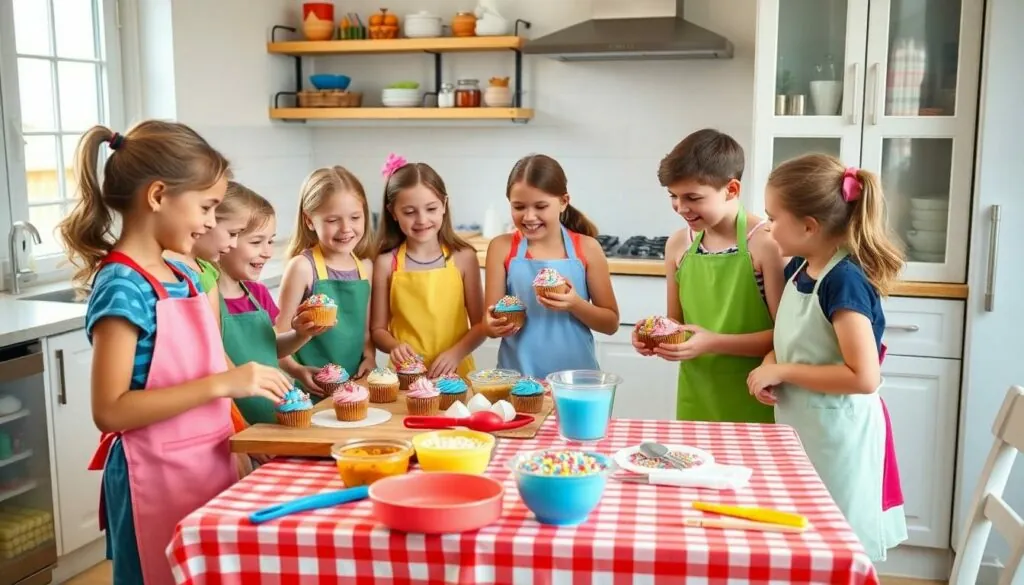Imagine a world where kids don chef hats, wield spatulas like swords, and whip up culinary masterpieces while giggling uncontrollably. A cooking party for kids isn’t just a fun idea; it’s a recipe for unforgettable memories. With flour flying and laughter echoing through the kitchen, young chefs discover the joy of cooking while developing essential skills that’ll serve them well beyond the kitchen.
Not only does this hands-on experience spark creativity, but it also teaches teamwork and responsibility—while sneaking in a few healthy eating lessons. Whether they’re crafting mini pizzas or decorating cupcakes, kids learn that cooking can be as fun as a rollercoaster ride, minus the long lines! So, roll up those sleeves, grab the aprons, and get ready for a culinary adventure that’ll have them begging for seconds.
Table of Contents
ToggleOverview Of Cooking Parties For Kids
Cooking parties for kids offer an exciting way to create lasting memories. These events engage children through hands-on culinary experiences, making the process enjoyable and educational. Group activities enhance social skills, allowing kids to practice teamwork while whipping up tasty treats.
Various projects can be incorporated into cooking parties. Mini pizzas empower children to express their creativity with toppings, while cupcake decorating allows for artistic flair. Learning about healthy eating becomes a central theme as kids discover nutritious ingredients.
Parents often appreciate the educational aspect of these gatherings. Cooking teaches essential life skills such as measuring ingredients and following recipes. Additionally, children learn the importance of food safety and hygiene, ensuring they develop responsible habits in the kitchen.
Catering to different age groups proves beneficial for planning. Younger children may need simpler recipes, while older kids can tackle more complex dishes. Organizing age-appropriate tasks keeps everyone engaged and minimizes frustration.
Inviting friends creates an atmosphere of excitement and collaboration. Cooking as a group fosters friendships while working towards a common goal. The shared experience of creating delicious food promotes bonding among peers.
Incorporating themes is another way to enhance cooking parties. Themes such as Italian night or dessert extravaganza add an element of fun and encourage creativity. A well-planned theme can inspire menu choices and decorations, creating a cohesive experience for everyone involved.
Overall, cooking parties provide an enriching blend of fun, education, and social interaction, ensuring kids enjoy their culinary exploration while developing valuable skills.
Benefits Of Hosting A Cooking Party
Cooking parties for kids create unique experiences that foster essential skills. Engaging in culinary activities encourages kids to express their creativity while having fun.
Enhancing Creativity
Hands-on cooking stimulates children’s imagination. Experimenting with flavors and ingredients allows them to create personalized dishes. Visual presentation becomes an avenue for artistic expression as kids design their plates. Collaborating in teams sparks innovative ideas, leading to unexpected culinary masterpieces. Each child’s taste preferences contribute to a diverse menu, enhancing creativity further. Learning about food combinations also inspires kids to explore new culinary concepts. Overall, cooking nurtures creativity while providing an enjoyable way to explore cuisines.
Building Life Skills
Cooking parties teach valuable life skills essential for personal growth. Kids learn to measure ingredients accurately, enhancing their math skills. Following recipes instills the ability to focus on tasks and improves reading comprehension. Understanding food safety and hygiene reinforces the importance of cleanliness in the kitchen. Teamwork during cooking fosters collaboration and communication, vital skills for social interactions. Completing tasks together strengthens problem-solving abilities as kids navigate challenges. As they participate, children gain confidence in their capabilities, laying a foundation for future culinary adventures.
Planning The Perfect Cooking Party
Planning a cooking party for kids involves thoughtful preparation to ensure a memorable experience. Key elements include selecting a suitable theme and choosing an appropriate date and time.
Choosing A Theme
Selecting a theme sets the tone for the cooking party. Popular options include Italian night, taco fiesta, or dessert extravaganza. Each theme can dictate the menu, decorations, and activities. Consider what interests the children: pizza-making encourages creativity in toppings while cupcake decorating allows for artistic expression with frostings and sprinkles. Each theme fosters excitement and engagement, enhancing the overall experience. Capture children’s attention by incorporating a fun storyline or character associated with the theme, sparking their imagination.
Setting A Date And Time
Choosing a date and time is crucial for maximum attendance and enjoyment. Weekends often work best, as they align with family schedules and allow ample time for activities. Aim for a duration of 2 to 3 hours, providing enough space for preparation, cooking, and tasting. Mid-afternoon slots may work particularly well, as kids may come hungry and eager to eat their creations. Send invitations at least two weeks in advance so everyone can adjust their plans accordingly. This strategic timing ensures a more relaxed atmosphere, allowing everyone to enjoy the cooking experience.
Recipes Ideal For Kids
Cooking parties can feature a variety of dishes that capture kids’ interest and creativity. Simple recipes allow young chefs to engage while learning essential cooking skills.
Simple And Fun Dishes
Mini pizzas offer an interactive and delicious option. Kids can personalize their own pizzas with toppings, fostering creativity. Another favorite is fruit skewers, where they combine colorful fruits on sticks for a healthy treat. Tacos also provide an exciting hands-on activity, allowing them to assemble their own fillings and toppings. Cupcake decorating engages kids’ artistic skills and creativity, resulting in unique designs and flavors. All these dishes promote teamwork, as kids work together to create their culinary masterpieces.
Safety Considerations
Safety plays a crucial role during cooking parties. Assigning age-appropriate tasks ensures children handle tools and ingredients safely. Teaching proper knife handling skills becomes essential when using kitchen tools, promoting confidence and care. It’s important for kids to understand kitchen hygiene, such as washing hands and surfaces to prevent cross-contamination. Supervising cooking processes keeps everyone safe and ensures fun remains the focus. Adults should monitor oven and stove usage, preventing accidents. By emphasizing safety, cooking parties create a secure environment for kids to explore their culinary skills.
Activities To Include
Engaging activities enhance cooking parties for kids. A well-rounded schedule features various cooking stations and interactive games that keep children entertained and involved.
Cooking Stations
Setting up multiple cooking stations creates a hands-on experience. Each station could focus on a different dish, like mini pizzas, fruit skewers, or cupcakes. Kids can rotate through the stations, ensuring everyone participates in preparing the food. Designating specific tasks at each station, such as chopping fruits or assembling pizzas, promotes teamwork and skill development. Safety remains a priority; supervision aids in effective learning while ensuring children practice food hygiene. Establishing a friendly competition for the best-looking dish encourages creativity and enthusiasm.
Games And Challenges
Incorporating games and challenges adds excitement to the cooking party. Fun activities like a timed cupcake decorating contest or a pizza-making relay promote friendly competition. These challenges motivate children to work together and think critically under time constraints. Setting up a scavenger hunt for cooking ingredients engages kids in a playful way while reinforcing their learning. Additionally, including trivia questions about food or cooking can spark discussions and deepen their understanding of culinary concepts. Overall, games and challenges make the cooking experience memorable and enjoyable.
Conclusion
Cooking parties for kids are a fantastic way to blend fun with learning. These events not only spark creativity but also instill essential life skills. By engaging in hands-on activities, children build confidence while enjoying the process of cooking.
The social aspect of these gatherings fosters teamwork and strengthens friendships. With thoughtful planning and age-appropriate tasks, parents can create unforgettable experiences that resonate with kids long after the party ends.
Ultimately, cooking parties offer a delightful opportunity for children to explore their culinary talents, making every gathering a memorable adventure filled with laughter and learning.




